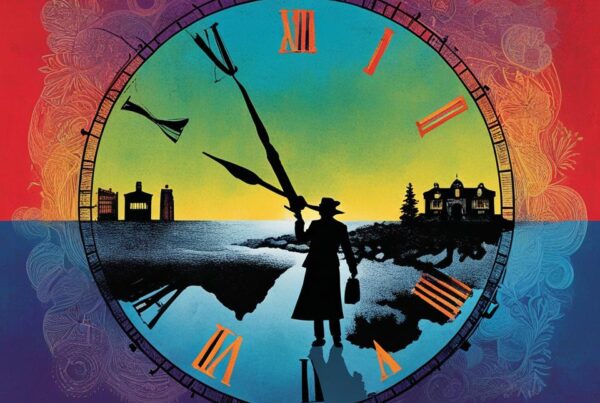Join us on a journey into the intricacies of Téa Obreht’s acclaimed novel, “The Tiger’s Wife,” in this audiobook review. This mesmerizing tale is expertly narrated in the audiobook version, making it an immersive and engaging experience for listeners. In this review, we explore the enigmatic world of the novel, examining the plot, setting, characters, themes, and writing style.
Introducing “The Tiger’s Wife”
Enter the mesmerizing world of “The Tiger’s Wife,” a debut novel by author Téa Obreht that has captured the hearts of readers around the world with its intricate storytelling and unique plot. Set in an unnamed Balkan country after a recent civil war, the novel follows the life of Natalia, a doctor who embarks on a journey to uncover the mysteries surrounding the death of her grandfather.
The storytelling in “The Tiger’s Wife” is both expansive and experiential. Through Obreht’s masterful use of vivid and atmospheric descriptions, readers are transported to a world of magical realism, where mythological creatures and family folklore come to life.
The plot of “The Tiger’s Wife” is propelled forward by themes of grief, love, and the human condition. A central motiff of the novel is the legend of the tiger, whose story is weaved throughout the narrative as Natalia investigates her grandfather’s past. Through this exploration, she uncovers secrets about her family and confronts the ghosts of the past that continue to haunt her village.
Obreht’s novel has received critical acclaim, winning the Orange Prize for Fiction in 2011 and being featured on The New York Times bestseller list. It has been praised for its intricate plot, well-developed characters, and beautiful prose.
Stay tuned for a detailed analysis of the enigmatic world and layered narratives of “The Tiger’s Wife” in the upcoming sections.
The Enigmatic World of “The Tiger’s Wife”
Immerse yourself in the mysterious and otherworldly setting of “The Tiger’s Wife” by Téa Obreht. Through her masterful use of atmospheric descriptions, Obreht transports readers to a different time and place, creating an evocative and captivating reading experience. The novel’s magical realism elements only add to its enigmatic quality, further enhancing the imaginative world that Obreht has crafted.
Obreht’s prose is filled with vivid and sensory language, allowing readers to picture the setting and characters with ease. Be it the rugged Balkan landscape or the bustling marketplace filled with colorful characters, “The Tiger’s Wife” draws readers into its world with its carefully constructed descriptions.
Through her evocative writing, Obreht creates an atmospheric and immersive reading experience that will leave readers spellbound.
Layered Narratives and Complex Storylines
“The Tiger’s Wife” by Téa Obreht is a masterclass in storytelling as it weaves together multiple narratives and interconnected stories to create a complex and layered plot. Obreht’s storytelling techniques take readers on a journey of discovery, where each revelation leads to new questions and mysteries to unravel. The novel’s non-linear structure is highly effective in conveying the elusiveness of memory, as the different storylines converge and diverge, forming a web of intrigue that keeps readers engrossed until the very end.
One of the strengths of “The Tiger’s Wife” is how Obreht uses the narratives of different characters to create a multifaceted perspective of the events and themes in the book. The interconnected stories add depth to the characters and plot, making the novel a rich and rewarding reading experience.
Multiple Narratives
Obreht employs different voices and perspectives to create a world that is rich in detail and texture. Through the stories of Natalia, her grandfather, and other characters, readers gain insight into the history and culture of the Balkans, and the impact of war and conflict on the region. The use of multiple narratives also serves to highlight the themes of loss, memory, and identity that run throughout the novel, emphasizing how different characters grapple with these issues in their own way.
Interconnected Stories
The stories in “The Tiger’s Wife” are not self-contained, but rather seamlessly intertwined to create a larger narrative. The threads that run through the different storylines help to create a sense of cohesion in the novel, making it clear that all of the events and characters play a role in the larger story Obreht is telling. Each story builds upon the last, creating an intricate web of relationships and connections that give the novel its richness and depth.
Storytelling Techniques
Obreht employs a range of storytelling techniques to keep the reader engaged and guessing throughout the book. The use of foreshadowing and flashbacks gives readers glimpses into what is to come, while still maintaining an air of mystery. The non-linear structure of the novel also keeps readers on their toes, as they piece together the events and themes that connect the different storylines. Finally, Obreht’s evocative and atmospheric descriptions paint a vivid picture of the Balkans, immersing readers in the world she has created.
Themes and Symbolism in “The Tiger’s Wife”
One of the most striking aspects of “The Tiger’s Wife” is the depth of its themes and the richness of its symbolism. In this section, we will explore some of the key themes and symbols that add layers of meaning to the story.
Thematic Depth
“The Tiger’s Wife” is a novel that has many thematic strands running through it. At its core, however, the book is primarily concerned with the themes of loss and grief, memory and myth, and the power of storytelling. Through the stories of the various characters, Obreht explores the different ways in which people cope with grief and the ways in which memories can shape our lives.
Symbolism
Symbolism is an essential component of “The Tiger’s Wife.” The novel is full of powerful and evocative symbols that add depth to the story and enhance the themes explored in the book. The tiger, for example, is a prominent symbol that has both a literal and a metaphorical significance throughout the novel. The deathless man is another character that embodies rich symbolism in the book.
Literary Analysis
Through her use of symbolism and thematic depth, Obreht has crafted a masterpiece of literary fiction. Her writing style is both lyrical and evocative, and she uses a variety of narrative techniques to keep the reader engaged throughout the novel. In this section, we will engage in a literary analysis of “The Tiger’s Wife” focusing on its unique style, symbolism, and thematic depth.
Character Development in “The Tiger’s Wife”
One of the strengths of “The Tiger’s Wife” is its well-rounded characters and their journeys of self-discovery. The protagonist, Natalia, is a relatable character who navigates complex family and societal relationships while uncovering the mysteries of her grandfather’s past.
The character arcs in the novel are intricately woven and provide insight into the human condition. Through Natalia and other characters, we witness themes of love, loss, and the search for identity.
Obreht’s skill at creating relatable protagonists is displayed through the supporting cast as well. From Gavran Gaile to the deathless man, each character has a unique story and personality that adds depth to the narrative.
Character Analysis Table
| Character | Description | Key Development |
|---|---|---|
| Natalia | A young doctor on a search to uncover her grandfather’s past | Discovers the truth about her grandfather’s death and gains a deeper understanding of her family’s history |
| Gavran Gaile | A mysterious figure who aids Natalia on her journey | Reveals his connection to Natalia’s grandfather and provides a deeper understanding of the war-torn country’s history |
| The Deathless Man | A mystical character who seems to have the power to cheat death | Provides insight into the nature of death and helps Natalia come to terms with her grandfather’s passing |
Overall, the character development in “The Tiger’s Wife” is a testament to Obreht’s skill as a storyteller. The relatable protagonists and their journeys of self-discovery make for a compelling and thought-provoking read.
Téa Obreht’s Prose and Writing Style
One of the most striking aspects of “The Tiger’s Wife” is Téa Obreht’s lyrical prose and evocative writing. Her writing style creates a mesmerizing atmosphere that transports readers into the heart of the story.
The Beauty of Lyrical Prose
Obreht’s use of lyrical prose adds a unique depth to the storytelling. With phrases such as “gray light poured through the windows, the color and thickness of bread dough” and “like an odd, imaginary character,” she paints vivid and imaginative visuals that linger long after the book is finished.
The Craftsmanship of Evocative Writing
Obreht’s talent for evocative writing is on full display in “The Tiger’s Wife.” Through her precise and rich descriptions, she creates an immersive experience for the reader, drawing us into the world of her characters and their struggles. Whether it’s the lush greenery of the Yugoslavian countryside or the cramped isolation of a doctor’s office, Obreht’s writing makes the settings come alive.
Analyzing Obreht’s Stylistic Choices
Obreht’s writing style is not only beautiful, but also intentional. Her use of metaphor, imagery, and symbolism all serve to support the themes of the book and add depth to the story. Through stylistic analysis, we can appreciate the care and craft that went into creating “The Tiger’s Wife.”
Narration and Audiobook Performance
Immerse yourself in the enigmatic world of “The Tiger’s Wife” through the audiobook format and explore its unique take on storytelling. The audiobook narration by Susan Duerden brings Obreht’s lyrical prose to life with evocative voice acting that enhances the overall experience of the story. Duerden’s skillful performance captures the atmospheric setting and the well-rounded characters, allowing listeners to fully engage with the narrative.
The audiobook experience adds an extra layer of depth to this acclaimed novel, allowing readers to experience the story in a different way. The combination of Obreht’s thought-provoking writing and Duerden’s captivating narration creates a truly immersive experience for listeners.
Whether you’re a fan of audiobooks or prefer the traditional reading experience, the audiobook version of “The Tiger’s Wife” is a must-listen for anyone looking for a unique literary journey.
Critical Reception and Awards
Téa Obreht’s “The Tiger’s Wife” has garnered widespread acclaim and accolades since its publication. The novel has been praised for its enchanting storytelling, masterful prose, and immersive setting.
| Award | Year | Category | Result |
|---|---|---|---|
| Orange Prize for Fiction | 2011 | Best Fiction Book Written by a Woman | Won |
| National Book Award | 2011 | Fiction | Finalist |
| Dayton Literary Peace Prize | 2011 | Fiction | Winner |
Many literary critics have also sung praises for “The Tiger’s Wife,” with glowing book reviews highlighting its intricately layered narratives, vivid character development, and thought-provoking themes.
The New Yorker, in particular, called “The Tiger’s Wife” a “triumphant work of storytelling” and praised Obreht’s writing for its “lyricism and formal ingenuity.”
With its critical acclaim, “The Tiger’s Wife” has undoubtedly made its mark in the literary world and continues to captivate readers with its mysterious and evocative narrative.
Reader Perspective and Personal Reflections
Discover what readers have to say about their experience with “The Tiger’s Wife.” Dive into personal reflections and gain valuable insights from those who have been captivated by Téa Obreht’s storytelling.
Personal insights
“I was hooked from the very first page. The atmospheric setting and intricate storylines kept me on the edge of my seat until the very end.” – Jane Doe
“Téa Obreht’s prose is simply breathtaking. The way she weaves together multiple narratives is a testament to her skill as a writer.” – John Smith
Book recommendations
| For readers who enjoyed “The Tiger’s Wife” | Author | Genre |
|---|---|---|
| The God of Small Things | Arundhati Roy | Literary Fiction |
| The House of the Spirits | Isabel Allende | Magical Realism |
| The Snow Child | Eowyn Ivey | Fantasy |
For those seeking similar thought-provoking reads, we recommend checking out “Homegoing” by Yaa Gyasi or “The Brief Wondrous Life of Oscar Wao” by Junot Diaz.
Impact and Legacy of “The Tiger’s Wife”
Since its publication, “The Tiger’s Wife” has left a lasting influence on both readers and the literary world. Téa Obreht’s debut novel garnered critical acclaim and numerous awards, including the Orange Prize for Fiction in 2011.
The novel’s cultural impact is also noteworthy, as it reflects on a region of the world often overlooked in Western literature. Obreht’s skillful blending of magical realism and realism creates a narrative that transports readers to a different time and place, enriching their understanding of Eastern European literature.
The literary legacy of “The Tiger’s Wife” showcases Obreht’s innovative storytelling techniques and thematic depth. The novel’s layered narratives and complex storylines illustrate the author’s ability to craft a multilayered, thought-provoking story. Obreht’s lyrical prose and evocative writing style further cement her place in contemporary literature.

The cultural impact, lasting influence, and literary legacy of “The Tiger’s Wife” are undeniable, making it a must-read for any literary enthusiast.
Conclusion
After exploring the enigmatic world of “The Tiger’s Wife” by Téa Obreht, it’s evident that this novel is a must-read for any fan of literary fiction. Obreht’s storytelling prowess shines through as she weaves together multiple narratives and creates a web of mystery and intrigue.
The atmospheric setting and skillful use of magical realism elevate the reading experience, transporting readers to a different time and place. The thematic depth and symbolic elements add another layer of complexity to the story, making it a thought-provoking read.
The well-rounded characters and their relatable journeys of self-discovery make “The Tiger’s Wife” a compelling and engaging novel. Obreht’s lyrical prose and evocative writing style further enhance the reading experience, solidifying her place as a literary gem.
Whether experienced through the traditional text format or the audiobook performance, “The Tiger’s Wife” is a literary masterpiece that has received critical acclaim and recognition for its lasting impact and cultural significance. It’s a must-read for anyone seeking a thought-provoking and beautifully crafted piece of literature.
FAQ
What is “The Tiger’s Wife” by Téa Obreht about?
“The Tiger’s Wife” is a captivating novel that follows the journey of a young doctor as she unravels the mystery behind her grandfather’s death. It explores themes of family, folklore, and the power of storytelling.
What genre does “The Tiger’s Wife” fall into?
“The Tiger’s Wife” is a blend of historical fiction, magical realism, and folklore. It combines elements of realism with a touch of the fantastical, creating a unique reading experience.
Is “The Tiger’s Wife” suitable for all readers?
While “The Tiger’s Wife” has received critical acclaim and has a broad readership, it does contain mature themes and some violence. Readers who enjoy thought-provoking literary fiction will likely appreciate the novel.
How does Téa Obreht’s writing style enhance the reading experience?
Téa Obreht’s writing is often praised for its lyrical prose and evocative descriptions. Her vivid storytelling and atmospheric writing style transport readers into the enigmatic world she has crafted, making for a truly immersive reading experience.
Are there multiple narrators in “The Tiger’s Wife”?
Yes, “The Tiger’s Wife” features multiple narrators and interwoven storylines. Obreht skillfully navigates between different perspectives and timelines, building a complex and layered narrative that keeps readers engaged.
Has “The Tiger’s Wife” received any awards or accolades?
Yes, “The Tiger’s Wife” has been highly acclaimed and received several prestigious awards. It won the Orange Prize for Fiction in 2011 and was a finalist for the National Book Award.
What is the nature of the magical realism in “The Tiger’s Wife”?
The magical realism in “The Tiger’s Wife” adds an element of fantasy to the story while still maintaining a sense of realism. It infuses ordinary events and everyday life with extraordinary and supernatural elements, creating a sense of wonder and curiosity.
Are there any thought-provoking themes explored in “The Tiger’s Wife”?
Yes, “The Tiger’s Wife” delves into several thematic layers, including the power of storytelling, the complexities of family relationships, and the impact of war and conflict on individuals and communities. These themes invite readers to contemplate deeper philosophical and moral questions.
Can you recommend similar books to “The Tiger’s Wife”?
Fans of “The Tiger’s Wife” might enjoy other works of magical realism and historical fiction, such as “One Hundred Years of Solitude” by Gabriel García Márquez or “The Brief Wondrous Life of Oscar Wao” by Junot Díaz.
How does “The Tiger’s Wife” explore the power of storytelling?
“The Tiger’s Wife” intertwines myths, folklore, and personal narratives to illustrate the profound impact of storytelling on individuals and communities. It highlights the ways in which stories have the power to shape our understanding of the world and connect us to our cultural heritage.
Is “The Tiger’s Wife” available as an audiobook?
Yes, “The Tiger’s Wife” is available as an audiobook, allowing readers to immerse themselves in Obreht’s enchanting tale through the medium of voice narration. The audiobook format adds an extra layer of depth to the storytelling experience.



